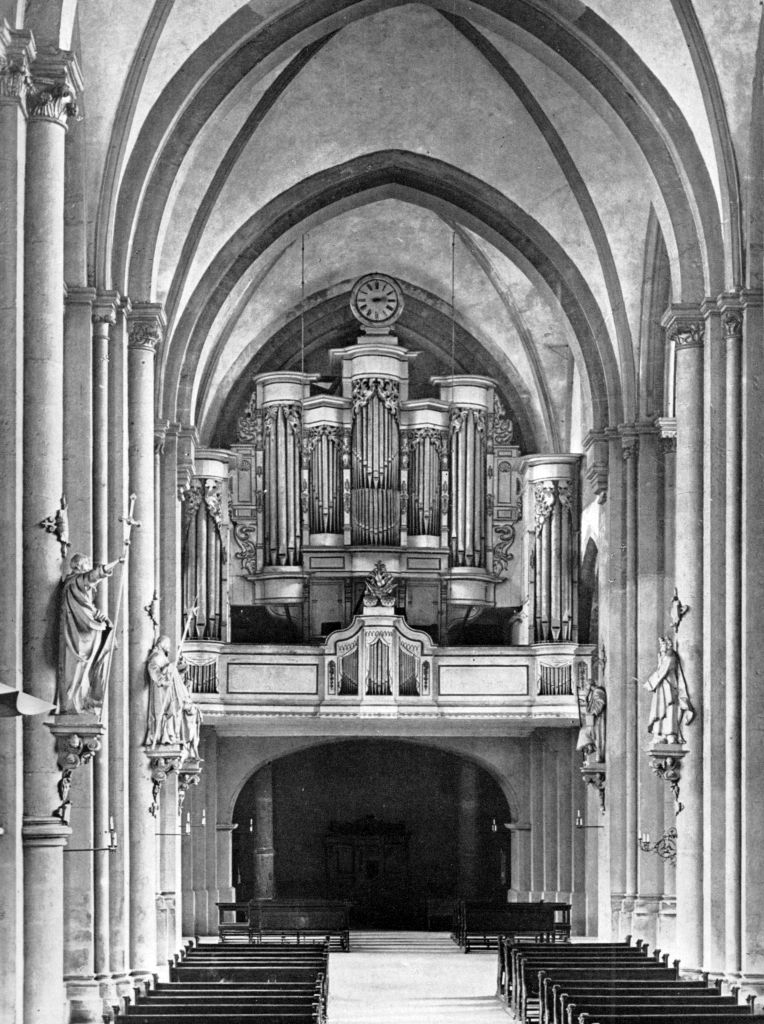Ausführliche Beschreibung der vorgewählten Orgel

Paderborn, Deutschland (Nordrhein-Westfalen) - Hohen Domkirche Sankt Liborius
Gemeinde: Paderborn
Region:Westfalen
Adresse: Domplatz 3, 33098, Paderborn
Website: https://www.dom-paderborn.de/
Beschreibung nr.: 2075071.
Gebaut von: Hans Henrich Bader (1627)
Demolished (1924)
Technische Daten
Disposition
Hauptwerk (CD-c'''): Principal 16', Oktave 8', Quintadena 8', Gemshorn 8', Viola di Gamba 8', Quinte 6', Oktave 4', Flöte 4', Quinte 3', Sesquialter 3 fach, Mixtur 5 fach, Cimbel 4 fach, Trompete 8', Trompete 4'.
Rückpositiv (CD-c'''): Principal 8', Gedackt 8', Flöte Travers 8', Oktave 4', Gedackt 4', Oktave 2', Quinte 1 1/2', Decima 2 fach, Mixtur 3 fach, Vox Humana 8'.
Oberwerk (CD-c'''): Bordun 16', Principal 8', Gedackt 8', Oktave 4', Hohlflöte 4', Quinte 3', Quintflöte 1 1/2', Cornett 3 fach, Mixtur 4 fach, Krummhorn 8', Vox Humana 8'.
Pedal: Principal 16', Subbaß 16', Oktavbaß 8', Oktave 4', Bauernflöte 2', Mixtur 7 fach, Posaunenbaß 16', Trompetenbaß 8', Trompete 4', Cornet 2'.

Paderborn, Deutschland (Nordrhein-Westfalen) - Hohen Domkirche Sankt Liborius
Gemeinde: Paderborn
Region:Westfalen
Adresse: Domplatz 3, 33098, Paderborn
Website: https://www.dom-paderborn.de/
Beschreibung nr.: 2075071.
Gebaut von: Hans Henrich Bader (1627)
Demolished (1924)
| Jahr | Orgelbauer | Opus | Aktivität | 1627 | Hans Henrich Bader | Neubau | 1655 | Hans Henrich Bader | Übersetzung | 1712 | Heinrich Mencke | Umbau | 1757 | Johann Patroclus Möller | Umbau | 1765 | Daniel Christoph Vahlkamp | Verschiedene Tätigkeiten | 1896 | Franz Eggert | Umbau |
- The old organ of the Domkirche in Paderborn was built in the years 1626-1627 by Hans Heinrich Bader. It was placed on the west side of the north aisle. In 1655 the instrument was moved by Bader to the west side of the nave. The organ case of Bader's main work existed until the restoration of the church in 1924, after which completely new organs were built by Anton Feith.
- The instrument has been rebuilt and expanded several times. First in 1709-1712 by Henrich Mencke. Johann Patroclus Möller carried out a renovation in the years 1754-1757. The balustrade has been renewed, as has the case of the Rückpositiv, after a design by the court architect Nagel. There were problems with the organ after the conversion, which were solved in 1765 by Daniel Christoph Vahlkamp.
- August Randebrock drew up a plan for a renewal in 1866, which was not carried out. Franz Eggert made a new design in 1890. This would have been carried out in 1895-1896, but this is not certain. In the years 1924-1926, new organs were built by Anton Feith, at the same time as a major restoration of the church building. The historic organ cases have not been re-installed.
- In the spring of 1895, Franz Eggert was commissioned to build a new organ for the cathedral in Paderborn. The instrument was probably delivered in 1896. In 1924 the church was restored, and new organs were built afterwards. Rudolf Reuter writes that Eggert's conversion plans (from 1890) were not carried out, and that the old organ was not replaced until 1924.
- The specification given is according to a notition from 1835.
Technische Daten
| Anzahl Register pro Manual | |
| - Hauptwerk | 14 |
| - Rückpositiv | 10 |
| - Oberwerk | 11 |
| - Pedal | 10 |
| Gesamtzahl der Stimmen | 45 |
| Tastentraktur | Mechanical |
| Registertraktur | Mechanical |
| Windlade(n) | Springchests, Slider chest (Rückpositiv) |
Disposition
Hauptwerk (CD-c'''): Principal 16', Oktave 8', Quintadena 8', Gemshorn 8', Viola di Gamba 8', Quinte 6', Oktave 4', Flöte 4', Quinte 3', Sesquialter 3 fach, Mixtur 5 fach, Cimbel 4 fach, Trompete 8', Trompete 4'.
Rückpositiv (CD-c'''): Principal 8', Gedackt 8', Flöte Travers 8', Oktave 4', Gedackt 4', Oktave 2', Quinte 1 1/2', Decima 2 fach, Mixtur 3 fach, Vox Humana 8'.
Oberwerk (CD-c'''): Bordun 16', Principal 8', Gedackt 8', Oktave 4', Hohlflöte 4', Quinte 3', Quintflöte 1 1/2', Cornett 3 fach, Mixtur 4 fach, Krummhorn 8', Vox Humana 8'.
Pedal: Principal 16', Subbaß 16', Oktavbaß 8', Oktave 4', Bauernflöte 2', Mixtur 7 fach, Posaunenbaß 16', Trompetenbaß 8', Trompete 4', Cornet 2'.
| Literatur |
|
